40 Years of Unreached Peoples Effort
Progress and Regress
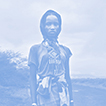
The work we are commemorating in this issue (1976-2016) did not occur in a vacuum, but was predicated by a paradigm shift in mission thinking. Powerful new ideas stimulated the imagination of believers, catalyzed their collective energies and birthed the modern frontier mission movement.
The dual concepts of 1) viewing the earth’s inhabitants in terms of people groups instead of nation-states, and 2) recognizing that a different kind of cross-cultural evangelism was needed to reach them, represented a paradigm shift within mission strategy that has been unparalleled in the twentieth century and beyond. It is hard to over-emphasize how significant these ideas were and remain. Viewing the world as people groups instead of nation-states more accurately represented how people actually think of themselves and brought clarity to the reality that there weren’t just a few hundred groupings of people to be evangelized but many thousands. It also brought the Church’s understanding of world evangelization into greater alignment with the real meaning of ethne or “nations” in the Great Commission, prioritizing ethnicity over nationality. Just as important, the idea that 87% of the world’s unreached population were not accessible to the witness of the world’s Christians, and that only by cross-cultural evangelism would they have a chance to hear, spurred the Church into a fortunate reassessment. It was no longer assumed that neighbors or similar people groups would automatically share the gospel across cultural barriers. By 1980, these ideas had matured and coalesced into a compelling narrative that launched the Church’s global outreach on a new trajectory.
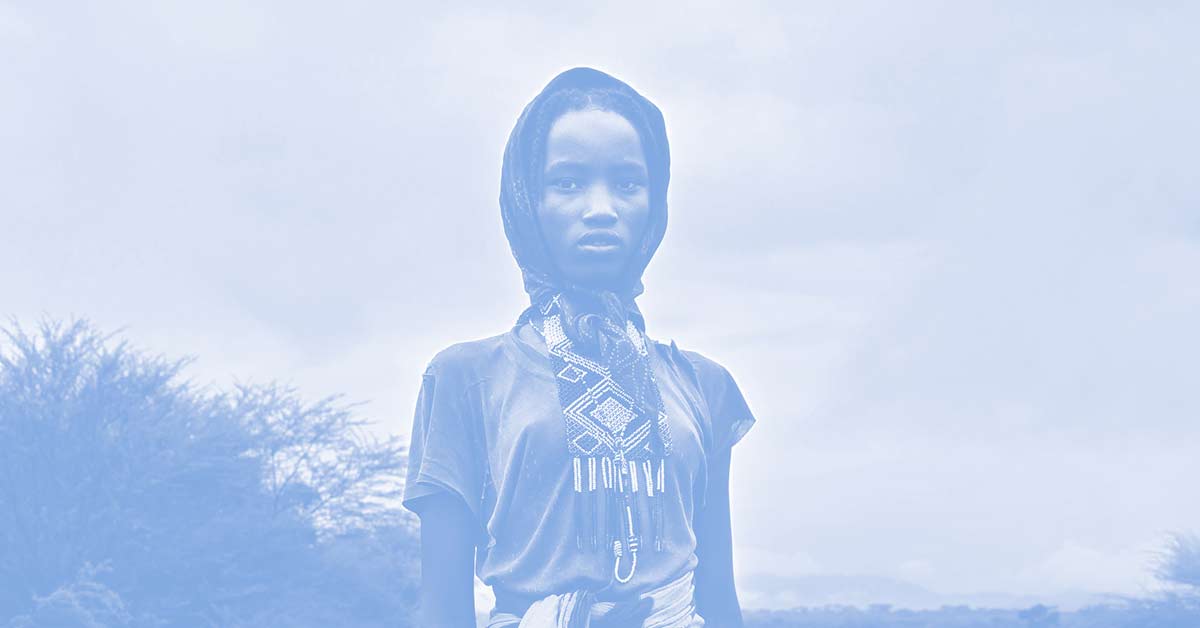
Progress
Specifically, “progress” over the last forty years in terms of reaching the unreached can be seen in the following realities:
1. There has been huge progress in identifying the unfinished task.
There is a saying, "a problem well stated is half solved." Great strides forward have been made regarding clarifying the remaining task of the Great Commission. When Ralph Winter and others first introduced unreached peoples, the numbers were strictly guesstimates. The last 20-25 years has seen the refinement of three global people group lists with real numbers. Having real data and increased clarity of the unfinished task is a great gift from the Lord and evidence of progress and something to celebrate. In the mid-1990s Joshua Project started out with a partial listing of about 1,750 of the largest unreached people groups. In the early 2000s the Joshua Project list was expanded to a comprehensive global list of 16,500 people groups. Many new unreached people groups were documented for the first time. Increased gathering and analysis of data brought greater clarity to the unfinished task.
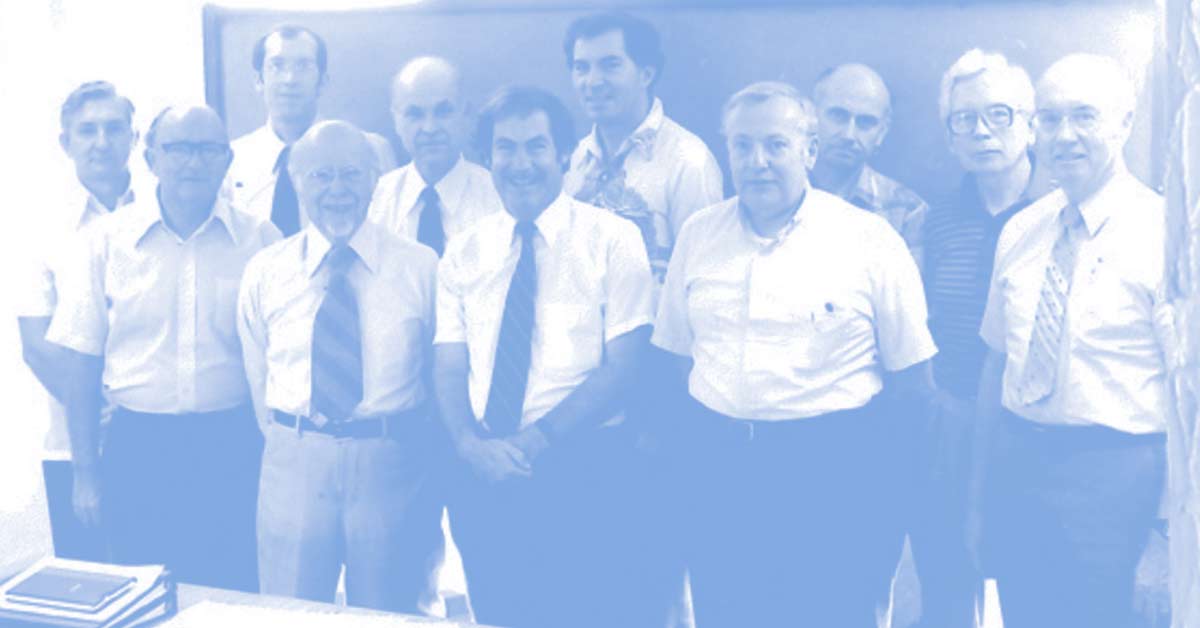
Today the global missions community is blessed with three major people group lists. The World Christian Database (WCD), International Mission Board (IMB) and Joshua Project (JP) people groups lists each provide unique perspectives on the unfinished task.
Not only was there progress in understanding exactly how many unreached people groups there were and where they were located in the world, but also in determining how we should reach them. As missionaries went to unreached peoples all around the world, the focus shifted from identification to methodology. As they came up against “barriers of understanding and acceptance,” new and sometimes controversial methodologies were tried with mixed results. Thus we have seen transformational shifts in how Bible translation is done, new openness toward and acceptance of supernatural signs and wonders as part of our witness, brow-furrowing and hand-wringing discussions on the type and extent of contextualization, concerns over funding and dependency, and a focus on movements with obedience-based discipleship at their core, to name a few. These forty years have been dynamic.
2. Hundreds of once-unreached people groups have been reached.
The exact number is impossible to know because changes in the way people groups were defined and identified means that comparing lists over years is comparing apples with oranges. Numerous people group changes, deletes, adds, splits and merges have occurred over the years that significantly cloud the unreached to reached picture. For example, for many years there were two unreached Zhuang people groups speaking two different Zhuang languages in China on the Joshua Project list. When the 17th Edition of the Ethnologue came out, SIL had determined that there were actually 12 very distinct Zhuang languages. Since the Joshua Project list is basically ethno-linguistic outside South Asia, by default a new people group is created when a new language is identified. Therefore, the original two Zhuang unreached people groups were split into twelve Zhuang groups based on the language speaker populations. Now instead of two unreached groups there were twelve on the list. The number of unreached people groups increased. Was this a move backwards? No, not really. Instead, there was a better picture of reality. The same number of individuals was involved, now just classified in twelve unreached groups rather than two unreached groups. There are hundreds of cases like this.
However, the undeniable truth is that over the last forty years, in hundreds of people groups, the gospel has not only arrived, but brought with it a viable, indigenous, ongoing church presence. Mission agencies around the globe can attest to this and share their own stories.
3. Mobilization efforts (especially through 2000) were incredibly fruitful and made lasting impact.
What began in the 70s flowered in the 80s and 90s. The capstone of this effort was the AD2000 and Beyond Movement, which promoted many tracks of action around the world among hundreds of agencies. Evidence of this incredible mobilization is found in the fact that, according to Patrick Johnstone, “The peak in the 1990s reveals that that decade saw more evangelical converts to Christ than any other in history. It may prove to be the greatest decade of harvest there will ever be.”
Another evidence of the fruitfulness of mobilization is the impact of people group thinking on various organizations and initiatives over the years:
- Denominational mission agencies have adopted the unreached peoples paradigm in major ways. The International Mission Board of the Southern Baptist Convention, one of the largest denominational sending agencies in the world, re-organized themselves completely around the people group concept. Other denominational sending agencies such as Assemblies of God, Baptist General Conference, Grace Brethren and Nazarene Missions have made their primary focus unreached people groups.
- Non-denominational mission agencies also jumped on the unreached peoples bandwagon, switching their focus in various ways. Dozens of agencies like YWAM, AIM, TEAM, and OMF joined the Adopt-A-People effort.
- Brand new agencies were born with a dedicated focus to unreached peoples, such as Frontiers, Pioneers, Mission to Unreached Peoples (now called Act Beyond), Advancing Native Missions, Team Expansion, Reach the Rest, etc.
- New networks solely dedicated to unreached peoples have risen up. Finishing the Task (FTT) has championed unengaged unreached people groups. FTT has documented over $1.8 billion dollars being raised toward UUPG ministry in the last ten years. They also have significant data on workers sent out to UUPGs and numbers of groups engaged over the last ten years. Other significant people-group-focused networks include Vision 5:9 and Ethne. Ethne and their Ephesus Vision seeks to foster cascading “Ephesus Movements” in this generation throughout the most neglected families of unreached peoples. Hundreds of people groups are being targeted through this network.
- Unreached Peoples Prayer networks—There is a growing convergence of the prayer and missions movements. There are numerous unreached people groups prayer networks such as Houses of Prayer, Praying Through the Window, Ethne Prayer Initiative, Inherit the Nations, ACTS School of Prayer, Fellowship of Prayer Strategists.
Finally, the greatest contribution of mobilization efforts over the last forty years has been the flourishing mission movement in Africa, Asia and Latin America. These mission fields have become sending bases, and are providing fresh zeal, new pools of missionary recruits, and in many cases, supernatural power.
Regress
While this progress has been undeniable, it has not been without difficulty, and there are signs of regress from the perspective of 2016.
1. There has been a massive slowdown in the pace of evangelization since 2000.
Each January, the International Bulletin of Missionary Research (IBMR) publishes a two-page article called, “Status of Global Christianity.” One important line on this chart has special import for our discussion. It shows the unevangelized as a percentage of world population.
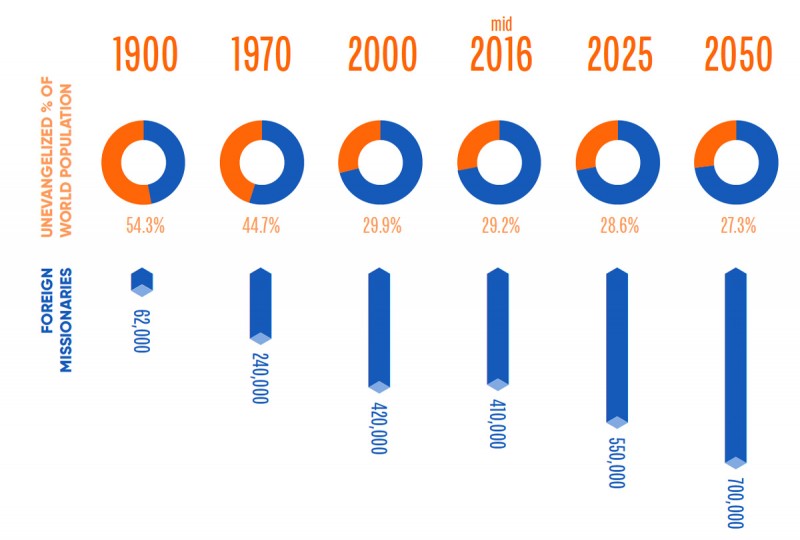
Our question: why is the percentage of the unevangelized going down so slowly after the amazing percentage decrease between 1970 and 2000? In that time period, there is a 15% decrease in 30 years (44.7 to 29.9). However, after that, the percentage decrease is only 1.3% between 2000 and 2025 (29.9 to 28.6) as well as 2025 and 2050 (28.6 to 27.3). What gives? We thought it might be caused by an overall population spike post-2000, but world population doesn’t appear to be that different in these time periods (massive growth of 2.4 billion between 1970 and 2000, which is commensurate with the projected 2 billion increase between 2000 and 2025, after which it decreases), so there must be another reason. By our admittedly reductionistic calculations, if the 1970-2000 percentage decrease had become the norm (15% decrease every 30 years), the world would be evangelized by 2060. By contrast, if you follow the trajectory from 2000-2050 (1.3% decrease every 25 years), the world will be evangelized by 2540.
Five hundred years is not a small difference! What happened after 2000 to stall what appeared to be a stunning decline in the unevangelized as a percentage of world population? Has the frontier mission movement itself stalled? Did the sprint for “a church for every people and the gospel for every person by the year 2000” leave us exhausted? Have world events post-2000 demoralized us? Has the continued secularization of Western Christianity led to a failure of missionary nerve? Is the pioneering chutzpah of previous generations being lost?
Some have suggested a relationship between these numbers highlighted above with the number of foreign missionaries. In the chart found above we also see the number of foreign missionaries.
Notice the dramatic increase in workers between 1900 and 2000, the present stagnation and the projected massive growth over the next ten years and beyond. The growth rate between 1970 and 2000 is 43%, followed by a negative growth rate between 2000 and 2016. There is likely a correlation between the number of workers and the decrease in percentage of unevangelized. One could argue that the post-World War II surge in workers helped to bring down the percentage of unevangelized. And while we sit in 2016 with 10,000 less workers than existed in 2000, the numbers are projected to increase (31% growth rate between 2000 and 2025, 27% between 2025 and 2050), most likely because of the rise of Global South workers. Might this coming jump in workers once again speed up the rate of evangelization?
Others believe that the reason for this apparent stalling of evangelization is that the low-hanging fruit has already been picked. And a likely derivative is that the remaining unreached peoples pose challenges that current methods have not overcome. This makes sense. Since the 70s there has been a surge of unreached peoples awareness that has sent hundreds of thousands of workers to the field with “a different type of evangelism.” Great strides have been made over these years. But now we find ourselves in a new reality.
We must say again that statistics are slippery and dogmatic statements based on the figures above would be foolhardy. However, perhaps it would be allowable to suggest that the reason for this sharp decline in evangelization is both quantitative and qualitative. Simply put, there are not enough workers. Many unreached people groups remain vastly underserved. But it goes far beyond more workers. To quote Ralph Winter, “More of the same will not get the job done.” There remains the all-important issue of methodology. From Jesus to Paul to Roland Allen to the present, how we go about evangelization matters. What paradigm-shifting changes need to take place within the frontier mission movement, in theory and practice, to see these last unreached peoples evangelized? Dear Reader, what will happen on our watch?
2. Specialized mission efforts (especially surrounding issues of justice) have become the new darlings of mission activity, replacing the unreached peoples concept.
To some extent, this is inevitable as new ideas always have more trending power than old ones. And of course, none of it is intentional. But the danger is in not recognizing that they are apples and oranges. Specialized ministries help us to clarify God’s mission, and should be considered tactical, while the unreached peoples concept is strategic or foundational. As a result, we are not just replacing one mission trend with another, we are moving from what is strategic to what is tactical. While these specialized ministries are absolutely necessary if we are to obey the clear warrants of scripture (“teaching them to obey”), they will all realize their best contribution under the overall unreached peoples strategy and not as a replacement of it. If the two are separated, we can once again go back to doing very important Kingdom work in entirely reached and needy contexts. Therefore, the unreached peoples concept cannot be seen as a trend, but as a biblically permanent fact of life and ministry.
3. The very legitimacy of the people group concept is being seriously questioned.
The argument here is that while the people group concept works well in rural areas, where there is homogeneity and clear social and cultural boundaries between peoples, it can no longer be applied to many urban settings, which contain complex mixtures of identity, making simple and coherent people group classification impossible. Without doubt, urban centers do create problems for people group classification. Identities are morphing all the time, but the data is not one-sided in this direction since many ethnic communities maintain close ties even in such identity-threatening diversity. It seems that the jury is still out on how this will play out in any given situation. It is all very contextually defined, creating the need for field strategies on-the-fly. There has yet to appear any definitive study or alternative classification that would cause us to abandon the people group concept. It remains the best working model, even with its challenges.
4. Confusion and dilution of the term “unreached” remains a problem.
The term unreached has led to significant confusion. Some misunderstand it to mean that no missionary has ever been to a group, i.e. reached the group physically. Others think that just because a people group is engaged that it is somehow reached. Even the on/off toggle unreached/reached creates problems when a group crosses some numerical threshold. They disappear off the radar for many when they may in fact still need significant mission effort. A people group is only considered reached when there is a viable, indigenous community of believing Christians involved in a church planting movement with adequate numbers and resources to evangelize this people group without outside assistance.
The term unreached has also been diluted by applying it to entities other than people groups e.g. my neighbors are unreached, lawyers in New England are unreached, the new “Dones” (done with church) movement are unreached. Certainly individuals in these segments are lost but they are not unreached because they live within a culture where there is a viable church movement, thus they have ready access to the gospel message and discipleship.
Challenge and Opportunity
There is at this very moment a kairos opportunity to catalyze breakthrough among the remaining unreached peoples. Those who have gone before us did not shrink back from great challenges. We at Frontier Ventures desire to continue working collaboratively and innovatively with the frontier mission movement, which is our family, the place where we find our identity and purpose. We have much to learn from you, our friends and colleagues. May God bring us closer than ever before in true partnership so that the love and life that is found in Jesus may be freely offered to all, without coercion or constraint. And may the Lamb receive the reward of his suffering, not in 500 years but in our generation.
COMPREHENSIVE GLOBAL PEOPLE GROUP LISTS
WHY THREE GLOBAL PEOPLES LISTS?
How many countries are there in the world? The answer depends on who you ask. Should there only be one list of countries in the world? Different perspectives on the same situation are a healthy thing. Looking at a picture from several angles often yields greater appreciation. Using different definitions and criteria can help clarify a task and highlight areas needing further research. People group database compilers are confronted by questions such as: Is language always the primary definer of a people group? Should caste be considered when defining a people group? Should Christian Adherents be considered when setting the criterion for unreached? Should unreached be defined by exposure or response to the gospel? What are acceptable sources for input and edits? The three global peoples lists answer these questions slightly differently and thus provide different but valuable perspectives.
World Christian Database (WCD) (http://www.worldchristiandatabase.org/wcd/) – The World Christian Database provides statistical information on countries, cities, languages, world religions, Christian denominations, and people groups. Data sources for the WCD include published and unpublished sources, field work, interviews, questionnaires and officially published reports of government-organized national censuses. The WCD peoples list is ethno-linguistic, meaning that a people group is primarily defined by language and then by ethnicity, and then by country of residence. Within a language group other factors such as race, tradition, history, and culture sometimes define a subsection of peoples. The WCD classifies peoples by Worlds A, B and C. World A peoples are groups with over 50% of the population unevangelized. The WCD is available in print or online by annual subscription. Suggested updates can be submitted to <[email protected]>.
IMB / CPPI (http://www.peoplegroups.org) – The IMB / CPPI peoples database is a global list of ethnic people groups from a church planting perspective. It is a private, secure online system that is used by regional and national IMB researchers to gather and submit people group data to the IMB central database. The CPPI list is generally ethno-linguistic and allows for subdivisions of languages based upon cultural or dialect distinctives. In some cases other criteria such as religion are used to define a people group. “Unreached” is defined as less than 2% Evangelical; % Christian Adherents is not considered. A key feature of the CPPI is the tracking of unengaged people groups—peoples without any active church planting occurring. A people group is considered engaged when church planting methodology is underway or being implemented. Suggested updates for review by IMB regional and national staff can be submitted to <[email protected]>.
Joshua Project (JP) (http://www.joshuaproject.net ) – The Joshua Project database is a global ethno-linguistic and ethno-cultural people group database from a church planting perspective. Joshua Project is an open system, gathering data from a variety of sources such as field missionaries and researchers, national and regional initiatives, census data and published sources. People groups on the Joshua Project list are defined by language, religion, culture and caste primarily based on on-site definitions. "Unreached" is defined as less than 2% Evangelical and less than 5% Christian Adherent. A distinctive of the Joshua Project list is defining people groups in South Asia primarily by caste / community and religion rather than by language. South Asia people group data is available at the country, state and district levels. Suggested updates can be submitted to <[email protected]>.
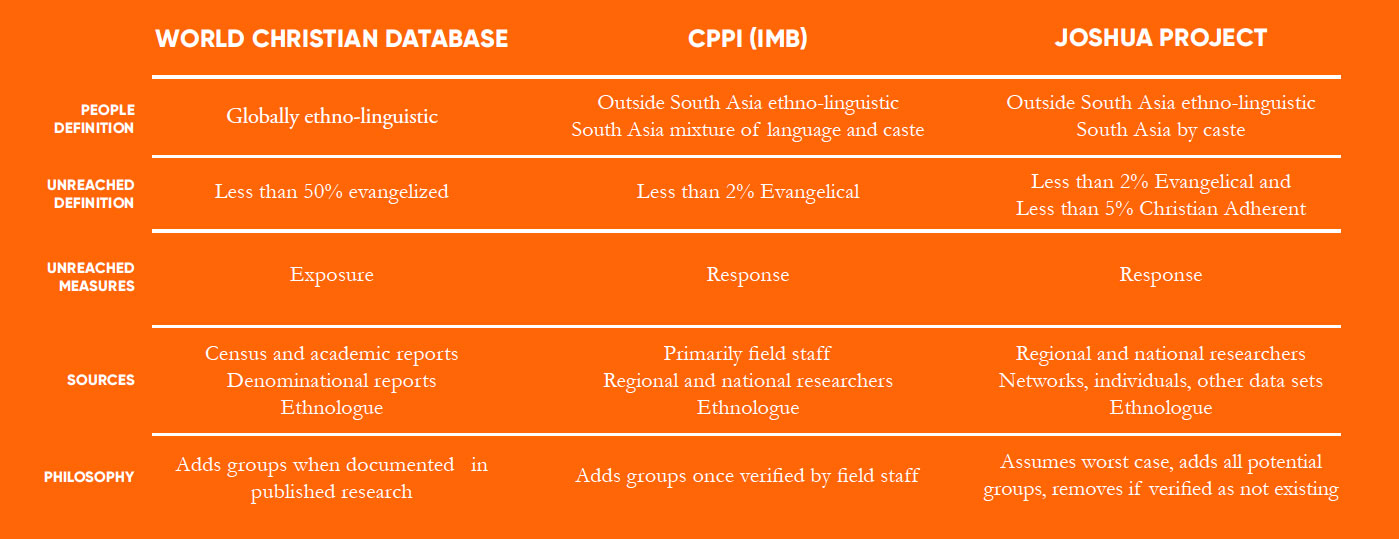
ENCOURAGING COOPERATION
In the last several years there has been a significant increase in the communication and cooperation between these three global peoples lists. Initiatives such as Global Trends Fruitful Practices / GTFP have provided the impetus for what has emerged as a peer-group of researchers and collaborative efforts to share and adjust information as much as possible. May the Lord continue to enhance and strengthen the developing connections between the World Christian Database, the IMB Global Research Office and Joshua Project.








comments